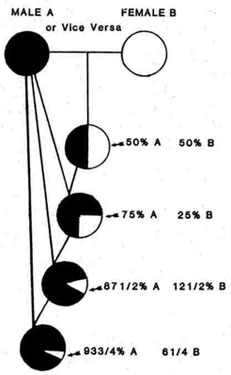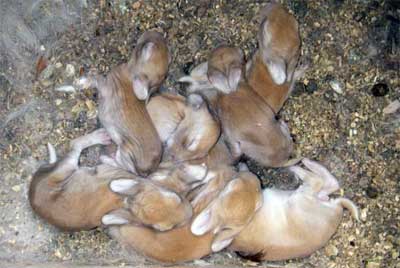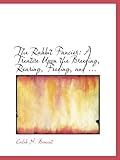Backyard Rabbit Keeping, Part 8/15 – Breeding
People who show rabbits are always trying to improve their stock by breeding to fix good points and eliminate bad ones. The backyard producer can introduce new blood by buying a fresh buck occasionally, and if this rabbit is fertile, healthy and of good type, there will be nothing to worry about. Life is rather simpler if you are not trying to breed for show points! However, perhaps we should take a brief look at the terms used by breeders.
Crossbreeding is the use of parents of different breeds. The resulting offspring may show ‘hybrid vigor’ as a result of their mixed ancestry but as crosses, they may not ‘breed true’ if used for breeding themselves. Many commercial rabbit producers use hybrids between various meat breeds. Fanciers would not dream of crossbreeding unless they were trying to fix a new type, such as when the various breeds were crossed with Rex rabbits to develop a rex variant.
Pure breeding is using two unrelated animals of the same breed. The best among the offspring of purebred rabbits can be used for further breeding, since they can be relied upon to produce animals similar to themselves – unlike the hybrids.
 Line breeding is practiced by the Fancy to try for show points; they use a good buck on a good doe and thereafter on several generations and it all gets rather complicated. This is a dangerous game, because breeding close relations can intensify bad points as well as good ones.
Line breeding is practiced by the Fancy to try for show points; they use a good buck on a good doe and thereafter on several generations and it all gets rather complicated. This is a dangerous game, because breeding close relations can intensify bad points as well as good ones.
In breeding just means the breeding together of related animals to concentrated the genes and produce rabbits that are predictable and all alike. It is again a risky practice in all but the most experienced hands and even then it can cause trouble.
Breeding can start when your animals reach maturity. Normally this will be at about five months for the does and six months for the buck. If in doubt, weigh them – they should be mature when they reach the proper adult weight, which varies widely according to the breed.
While you are waiting for them to grow up, handle them so that they are used to you and used to being taken out of their runs and pens and being put back again. Let them hop about the place if you can be sure that they won’t escape.
Put the male and the female together and if the time is right, they will mate. If not, try again about six hours later – the stimulation of the first meeting may have caused the doe to change her mind. The one golden rule with rabbits is that you always take the doe to the buck’s pen for mating. Put her in gently, back end first. When the buck has mated he falls over sideways, sometimes with a cry.

The gestation period is 31 days but it can be four days on either side of this. Commercial rabbit keepers are naturally anxious not to waste time and so their does are sometimes palpated – that is, they feel the sides gently to try to detect the embryos and decide whether the doe is pregnant. This should be done gently and takes a certain amount of skill. The doe is handled very carefully because if she is frightened her muscles will tighten and it will be useless to try to feel the embryos.
On the horns of the uterus the embryos are felt as marbles if the fingers explore the outside of the animal. 14 to 16 days after mating is reckoned to be the best time; but it does need practice. You could be handling fecal pellets, or internal organs. The main thing is to be gentle with her.

During the gestation period, watch the feeding. Remember she is carrying young and needs good quality food. The old books are very particular about this; people used to treat animals with great consideration when they gave birth. There isn’t much room for this sort of thing in modern farming and so it has gone out of fashion. But no doubt rabbit fanciers still have the time and the interest to make things really comfortable, feed warm bread and milk and this sort of thing. For the last week, they gave boiled linseed in the mash. Plenty of water is always important for does.
Sometimes a doe is restless and off her food just before she kindles. This is quite normal and does not indicate that anything is wrong. In fact, the birth will be easier if she is not stuffed full of food, so it is no bad thing for her to eat less for a short time. She will soon catch up again when she has a litter to feed.
 A few days before you expect the litter to be born, the hutch should be cleaned out and provided with a nest box containing fine hay. The mother will make her nest from the hay and from fur plucked from her belly. She will of course use whatever material you provide, but we have found hay to be best for baby rabbits. Anything else is too coarse, because the little ones are so small and have no fur. However full of bedding the box is, she will still arrange it so that the babies are lying on the actual floor, with the nesting material round the sides. This means that a warm floor is essential – a wooden one is best.
A few days before you expect the litter to be born, the hutch should be cleaned out and provided with a nest box containing fine hay. The mother will make her nest from the hay and from fur plucked from her belly. She will of course use whatever material you provide, but we have found hay to be best for baby rabbits. Anything else is too coarse, because the little ones are so small and have no fur. However full of bedding the box is, she will still arrange it so that the babies are lying on the actual floor, with the nesting material round the sides. This means that a warm floor is essential – a wooden one is best.
Rabbits are best left alone when giving birth. They are less likely to have trouble than larger animals and they clean themselves up afterward. But things can go wrong if the doe kindles in a nervous state, through having recently been moved or upset in some way. If this happens she may drop the young anywhere on the hutch floor and they can only be saved if you pick them up quickly and put them in the nest, otherwise they will get chilled and die. If they feel cool when you find them, stick them inside your shirt for a few minutes. So, even if they are best left alone, many breeders feel that it is best to be somewhere around at birth so that this sort of prompt action can be taken.
When the doe has finished and got over the birth, give her a tidbit to distract her attention while you have a look at the babies; it’s exciting to see how many there are. Any dead or deformed ones must be removed. Rabbits are very helpless at this stage – blind, deaf and naked. Handle them gently if you touch them at all, with hands rubbed in the bedding.
As the babies get bigger and need more milk, so the doe will need more food and water. The old rabbit keepers used to give their does raw potato to help the milk supply. Feel gently underneath the doe to find out whether her udder is normal, or whether it is hard and inflamed – the sign of mastitis. If she has this kind of trouble, try to squeeze out the milk and then bathe the udder.
By the time that they are a fortnight old, the babies’ eyes should be open; if they are a little sticky, bathe them.
As I said before, the babies will gradually come out of the nest box, explore the pen and begin to eat solid food. It is quite easy for a baby rabbit to drown in a deep water pot at this stage, so make sure that your dishes are safe – but make equally sure that the little ones can drink; they will need water when they begin to eat solid food.
 Weaning, in any natural rearing system, depends on the young ones’ progress more than their age. They should be lively, independent and eating solid food before they are deprived of the mother. There comes a stage when they can part without too much regret, or stress as they call it, on either side. The milk supply will be going down and the mother will be glad of a rest. The age of weaning rabbits varies quite a bit, by the age of one month they should be able to look after themselves. Some breeders leave them with the doe until they are two months old and take them from the mother for the table, but this needs a big hutch.
Weaning, in any natural rearing system, depends on the young ones’ progress more than their age. They should be lively, independent and eating solid food before they are deprived of the mother. There comes a stage when they can part without too much regret, or stress as they call it, on either side. The milk supply will be going down and the mother will be glad of a rest. The age of weaning rabbits varies quite a bit, by the age of one month they should be able to look after themselves. Some breeders leave them with the doe until they are two months old and take them from the mother for the table, but this needs a big hutch.
The best way for a backyard rabbit system is probably to leave all the litter together in a run if possible with access to grass, for part of the day at first, until they get used to it, and run them on there for the table with a few household scraps to supplement the grass.
It is possible to re-mate the doe while she is still suckling her litter. In some rabbitries it is done 3 to 12 days after kindling, but this gives her very little rest between litters. Others re-mate the doe when her litter is three weeks old.
If you are not desperate to get the last ounce of production from your rabbits, re-mate the doe at the time she is weaned. This will keep her going nicely without overdoing it. Unfortunately if you decide to give her a rest, she may start a pseudo-pregnancy and you will have to wait eighteen days for her to get over it.
Winter breeding can be a problem with outdoor rabbits; and it is worse in a hard winter. Wild rabbits as we saw have an off season for breeding as the days become shorter. Unless the rabbits are inside a shed, cold winter days might put them off mating. However, a commercial doe will only last 1¼ to 2 years and yet the life expectancy of a rabbit, biologically speaking, is about 9 years. Commercial rabbits have a short life and a fast one, but your rabbits will last longer. So if you are thinking of giving them a rest, keep them going in the summer and then you need not worry if they miss for a while in the cold weather. When the spring comes they will start again.
With this in mind – although sometimes you might get good results in the winter – I think you would be wise not to start a rabbit venture in the winter months. It could be so disappointing.
If you want autumn and winter litters, check that the stock is fit for a start. Keep them warm, and turn the hutch to get as much daylight as possible, with shutters at night to keep out the wind.
Artificial insemination is sometimes used for rabbits, but it is not so common as its use with cattle. It is more expensive than natural mating (whereas with cattle it works out cheaper) and is only used when a buck is to be tested on several does at once or if there is a problem with fertility.
A hormone has to be injected into the doe’s ear to induce ovulation and the whole thing seems to require a great deal of skill; so it is not really applicable to backyarding at all.
- Why Why Keep Rabbits?
- Rabbits Past and Present
- Some Basic Information
- Making a Start
- Housing
- Feeding
- Growing Crops for Rabbits
- Breeding
- Health
- Harvesting the Wild Rabbits
- The Harvest
- Using Rabbit Meat
- Fur Production
- Showing
- Angoras
Further Research:
   |
Leave a Reply